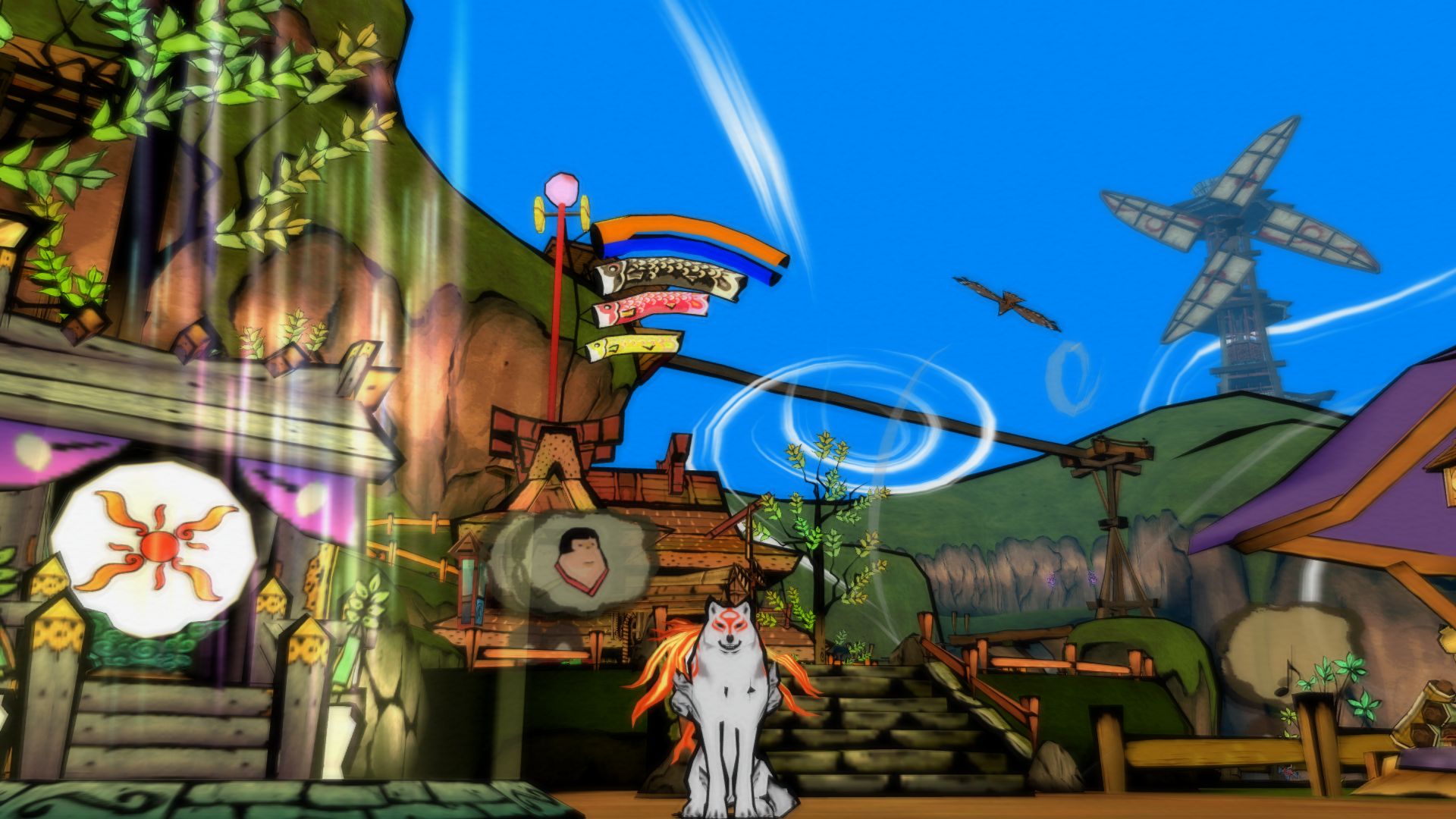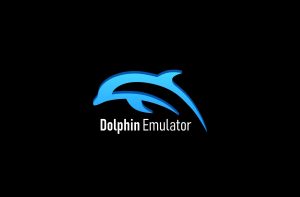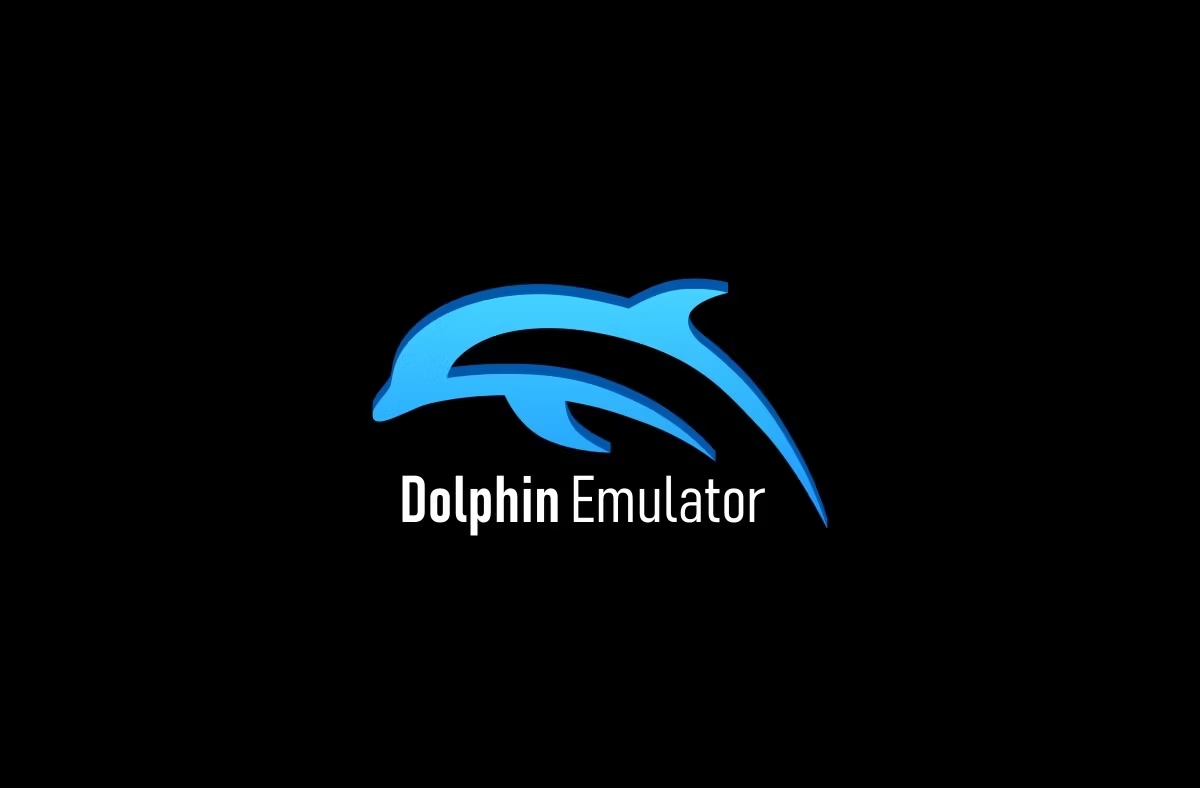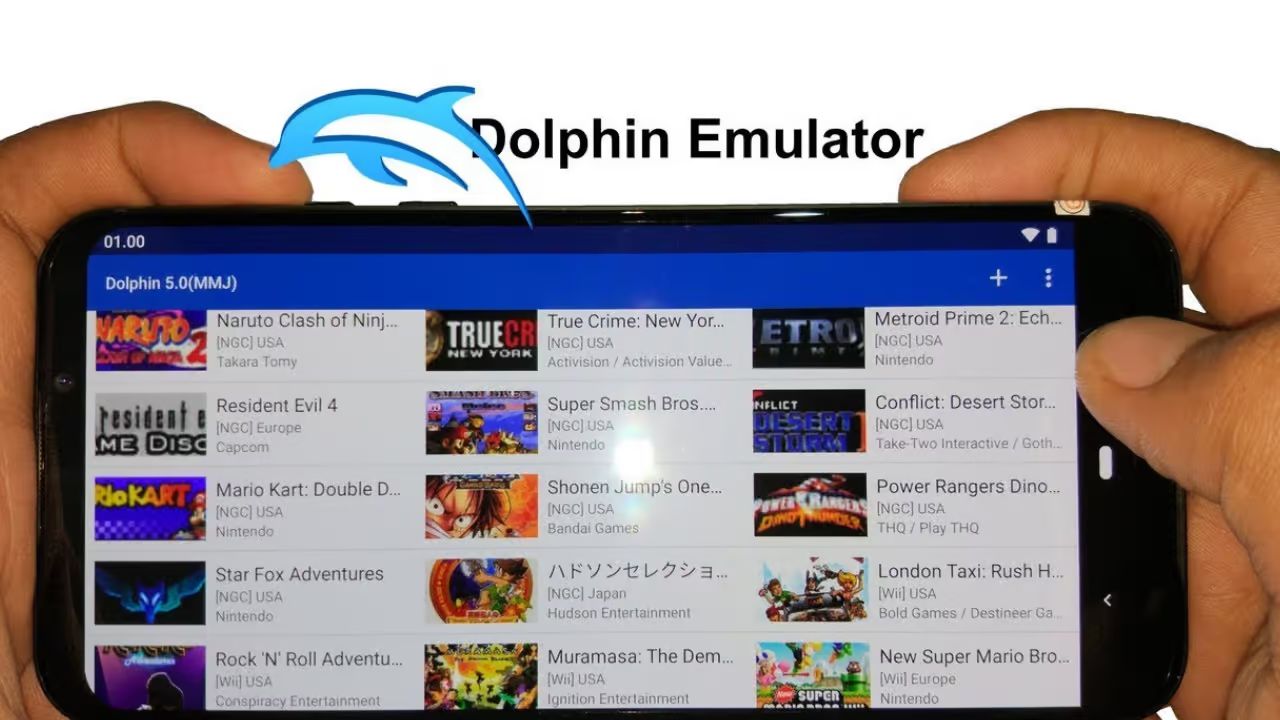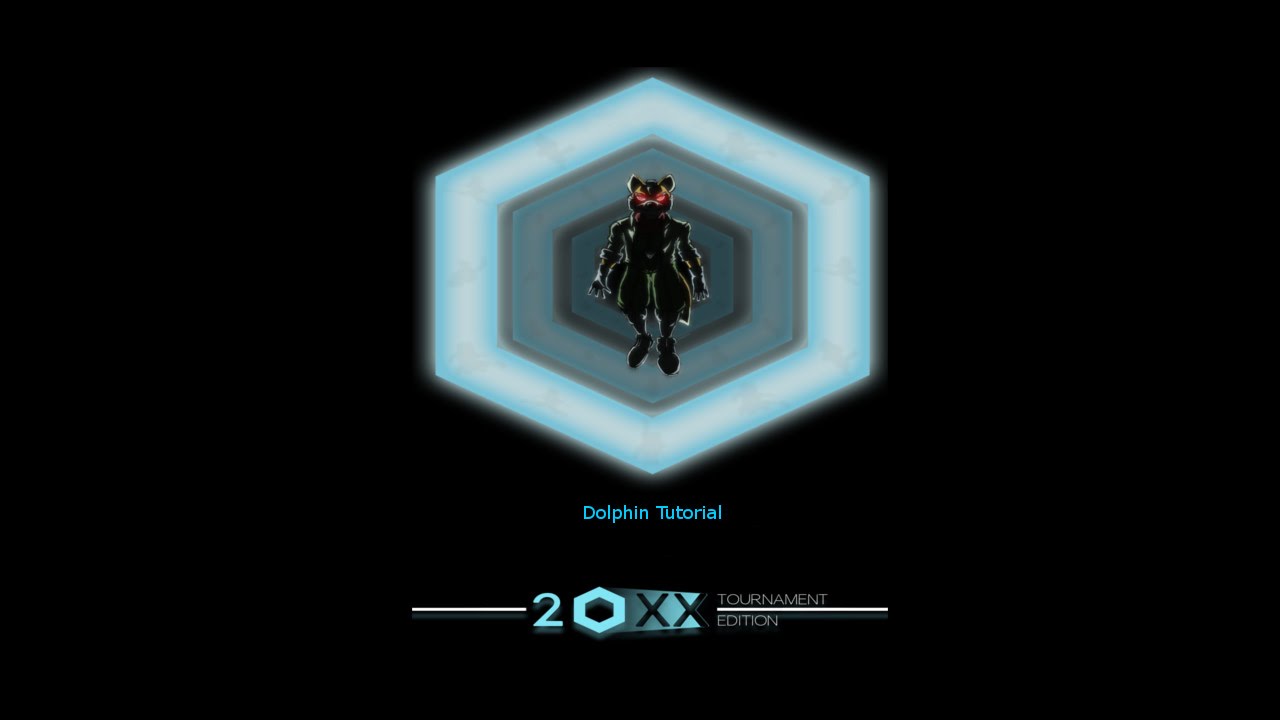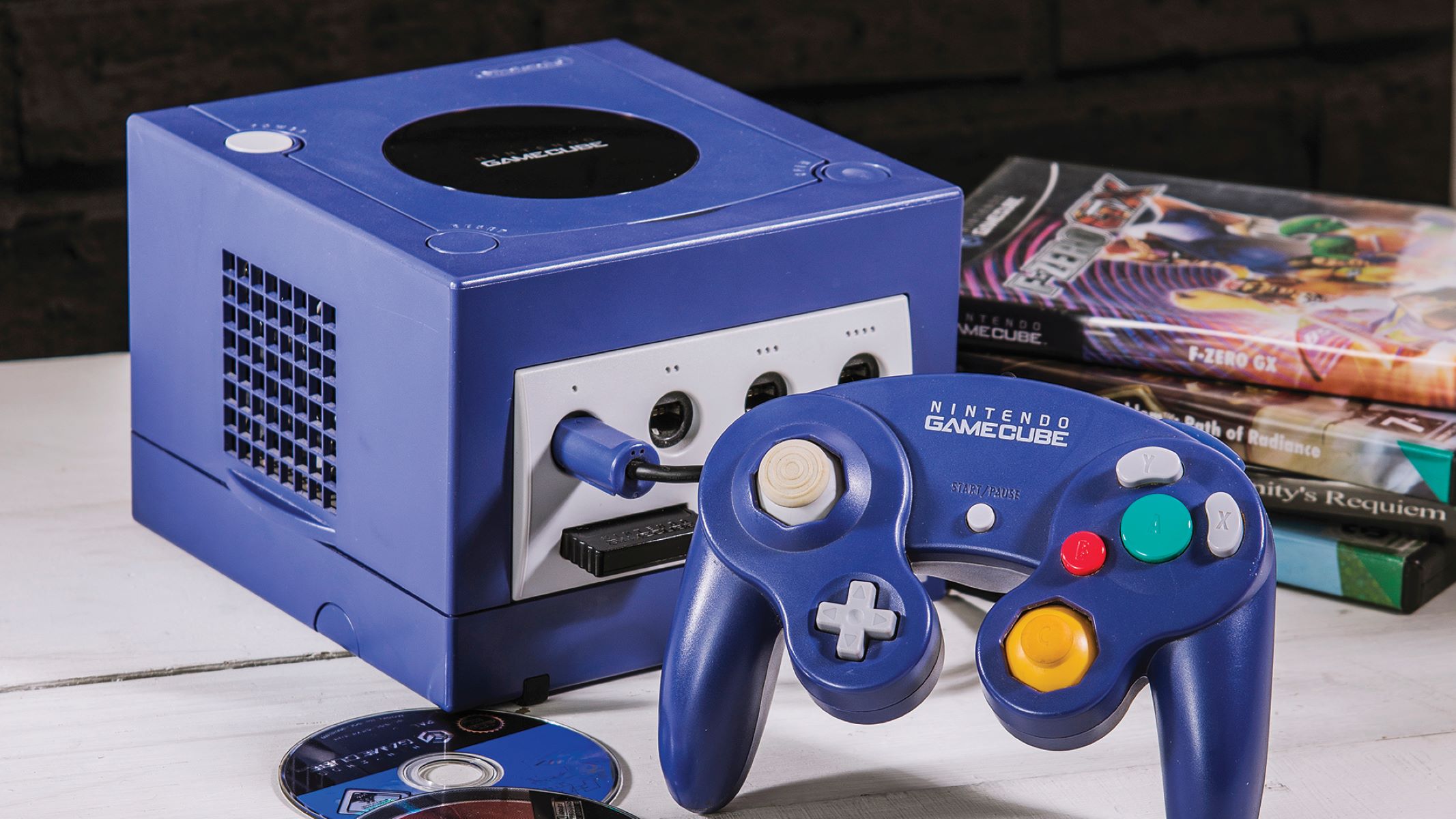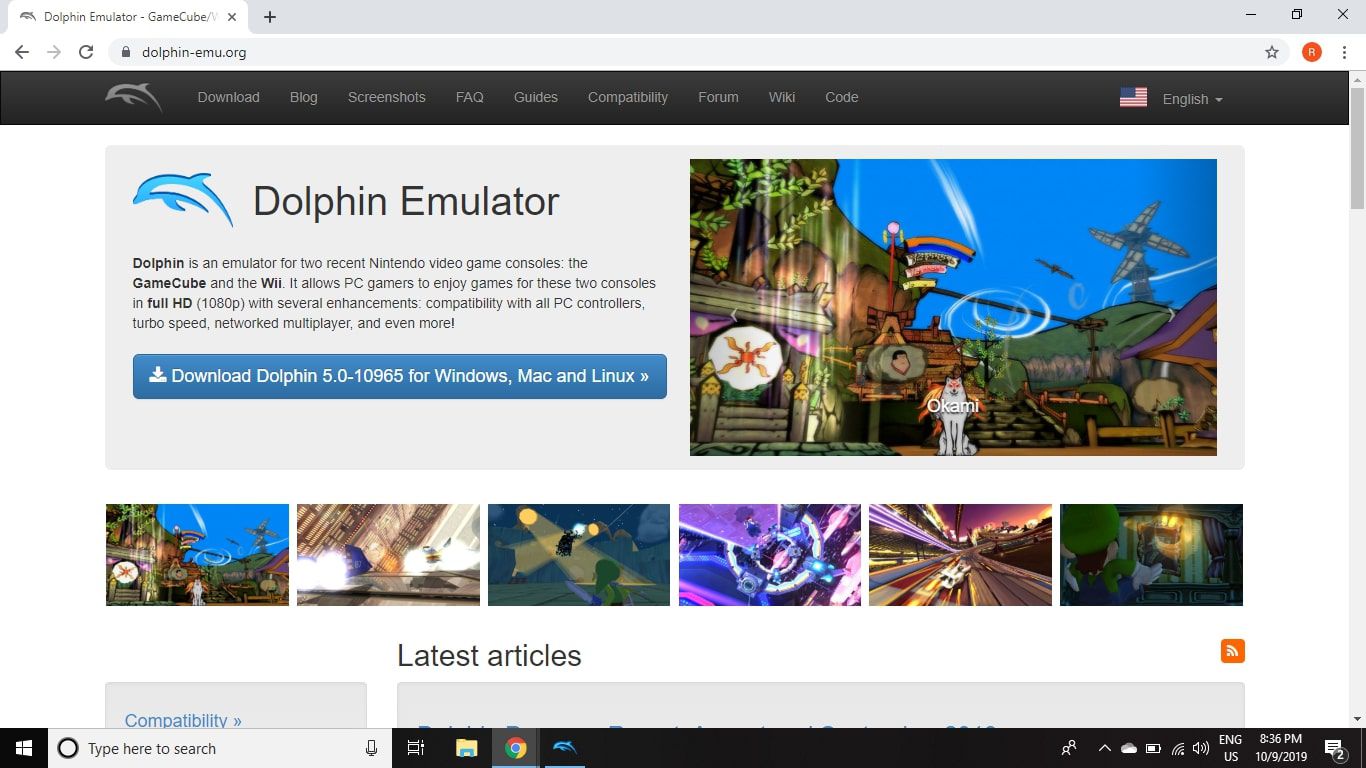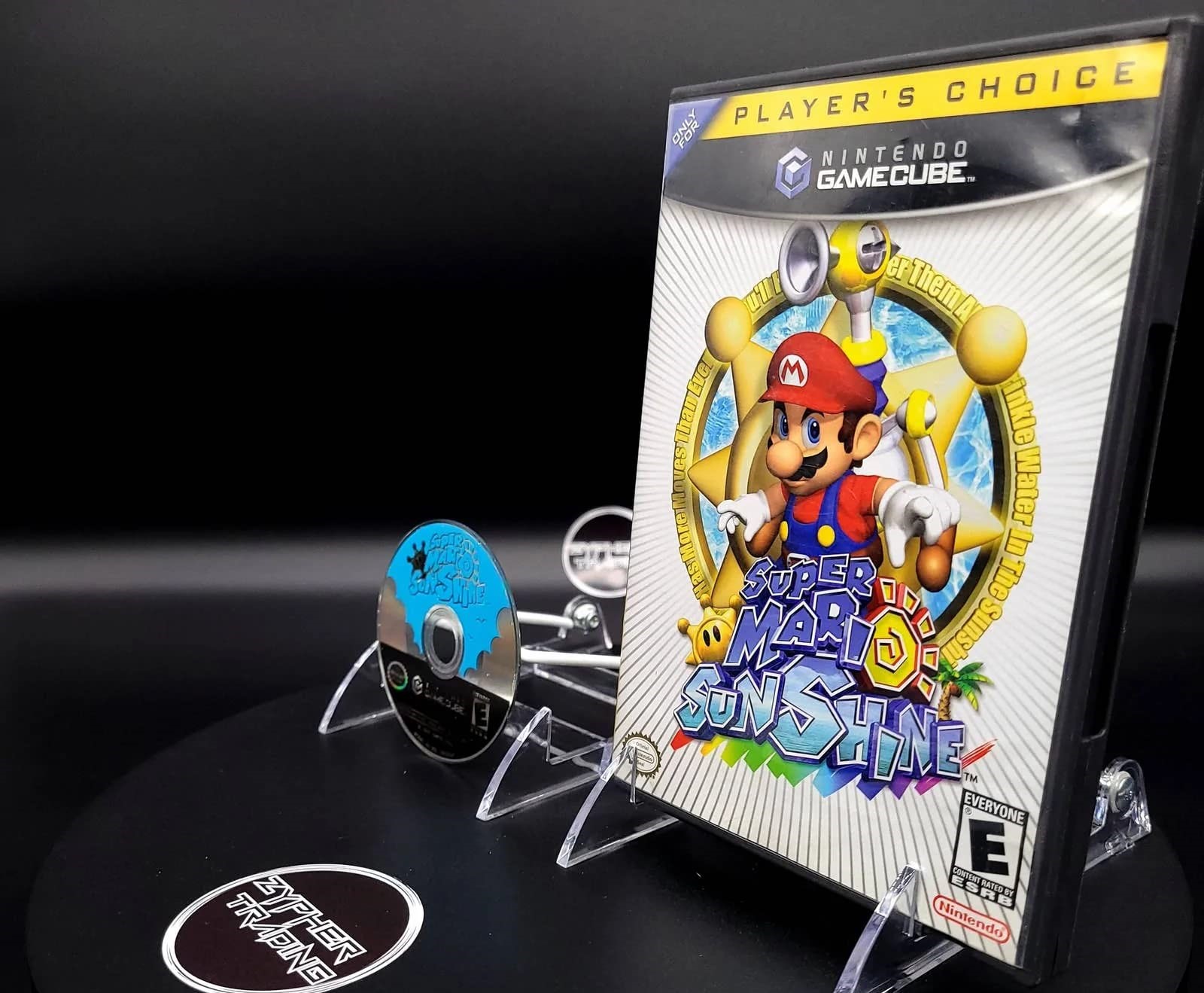Introduction
Welcome to the world of Dolphin, the ultimate emulator for playing Wii games on your computer! If you’ve ever wanted to relive the nostalgic experience of playing your favorite Wii games without the need for the actual console, Dolphin is the perfect solution for you. By installing Dolphin on your PC, you can enjoy a wide range of Wii games with enhanced graphics and performance.
Dolphin is an open-source emulator that allows you to play Wii and GameCube games on various platforms, including Windows, Mac, and Linux. With its user-friendly interface and extensive compatibility, Dolphin has become one of the most popular emulators among gamers worldwide.
In this guide, we will take you through the process of downloading and setting up Dolphin to play Wii games on your computer. Whether you want to play classic Wii titles or experience games in high definition, Dolphin provides the tools you need to make it happen. So, let’s dive in and get started!
What is Dolphin?
Dolphin is an open-source emulator specifically designed to emulate Wii and GameCube games on a variety of platforms. It was initially released in 2003 as a GameCube emulator, but over time, it has evolved into a full-fledged emulator capable of running Wii games with superb compatibility and performance.
As an emulator, Dolphin allows you to play your favorite Wii and GameCube games on your computer, offering a convenient and cost-effective alternative to playing them on the actual consoles. It mimics the functionality of a real Wii console, enabling you to experience the same gameplay and graphics without the need for additional hardware.
What sets Dolphin apart from other emulators is its commitment to accuracy and optimization. The development team has dedicated countless hours to ensure that games run smoothly and accurately, providing an authentic gaming experience for players. Dolphin has achieved a remarkable level of compatibility, with the majority of Wii and GameCube games running seamlessly on the emulator.
Dolphin is not just limited to Windows; it also supports macOS and Linux operating systems, widening its accessibility to a broader range of users. The emulator’s intuitive user interface makes it easy to navigate and configure settings according to your preferences. Additionally, Dolphin offers a wide array of customization options, allowing you to enhance graphics, improve performance, and even use modern gaming peripherals for a more immersive gameplay experience.
Overall, Dolphin has emerged as the go-to emulator for Wii and GameCube enthusiasts, offering a plethora of features and functionalities that cater to both casual and hardcore gamers. Whether you want to relive the classics or explore new titles, Dolphin provides a seamless and enjoyable gaming experience without the need for a physical console. So, if you’re ready to unlock a world of Wii and GameCube games on your computer, let’s move on to the next section and learn how to install Dolphin.
System Requirements
Before you jump into the world of Dolphin and start playing Wii games on your computer, it’s important to ensure that your system meets the minimum requirements for optimal performance. While Dolphin is a highly versatile emulator, it does require a relatively powerful computer to run games smoothly. Here are the system requirements you should consider:
- Operating System: Dolphin is compatible with Windows, macOS, and Linux. Ensure that your computer is running the latest version of your chosen operating system for optimal performance.
- Processor: Dolphin is a demanding emulator, so you’ll need a reasonably powerful CPU. A dual-core processor, such as an Intel Core i3 or AMD Ryzen 3, should be sufficient for most games. However, a quad-core processor or higher will deliver better performance.
- Memory (RAM): A minimum of 4 GB of RAM is recommended. However, for smoother gameplay and better multitasking, 8 GB or more is highly recommended.
- Graphics Card: Dolphin relies heavily on the graphics card for rendering high-quality visuals. While an integrated graphics card can work, it’s recommended to have a dedicated graphics card with at least 2 GB of VRAM for optimal performance.
- Storage: Make sure you have enough free space on your hard drive to install Dolphin and store the games. Wii games can take up several gigabytes of space, so having a sizeable hard drive or SSD is recommended.
- Controllers: To fully enjoy the Wii games, you’ll need compatible controllers. Dolphin supports a wide range of controllers, including gamepads, keyboards, and even real Wii remotes using a Bluetooth adapter.
While these are the minimum system requirements, it’s worth noting that more powerful hardware will result in better performance and visual enhancements. The ability to upscale and add anti-aliasing to games depends on your system’s capabilities.
Now that you know what system requirements are needed, you can determine whether your computer can handle running Dolphin. If you meet the requirements, you’re ready to move on to the next section, where we’ll guide you through the process of installing Dolphin on your computer.
Step 1: Installing Dolphin
Installing Dolphin on your computer is a straightforward process that allows you to start playing Wii games in no time. Here’s a step-by-step guide on how to install Dolphin:
- First, visit the official Dolphin website at https://dolphin-emu.org.
- Once on the website, navigate to the “Download” section.
- Choose your operating system (Windows, macOS, or Linux) and select the appropriate installer for your system. It’s recommended to download the latest stable release for the most stable and reliable experience.
- After the download completes, locate the installer file and run it.
- Follow the on-screen prompts to install Dolphin on your computer. Make sure to read and accept the license agreement.
- Once the installation is complete, you’re now ready to configure Dolphin and start playing Wii games!
It’s worth noting that Dolphin is regularly updated, and new features and improvements are introduced with each release. It’s recommended to check for updates periodically to ensure you have the latest version of Dolphin installed on your computer.
Now that you have Dolphin installed, it’s time to move on to the next step, where we’ll guide you on acquiring Wii games to play on Dolphin. Whether you own a physical copy of the games or prefer to download Wii ISOs from the internet, both methods will be covered in the following section.
Step 2: Getting Wii Games
Now that Dolphin is installed on your computer, the next step is to obtain Wii games that you can play on the emulator. There are two primary methods to acquire Wii games:
Method 1: Ripping Games from Your Own Wii Console
If you own a Wii console and have Wii games in your physical collection, you can rip those games and play them on Dolphin. Here’s how:
- Connect an SD card or USB drive to your Wii console.
- Install the Homebrew Channel on your Wii by following the respective guides available on the internet.
- Once the Homebrew Channel is installed, run a homebrew application called CleanRip.
- Follow the prompts in CleanRip to rip your Wii games onto the SD card or USB drive.
- Remove the SD card or USB drive from your Wii console and connect it to your computer.
- In Dolphin, go to the “Config” menu and select “Paths.”
- Click on the “Add” button next to the “Wii” option and navigate to the folder where you saved the game files.
- Once the folder is added, Dolphin will automatically detect the games, and you can now select and play them.
Method 2: Downloading Wii ISOs from the Internet
If you don’t own a Wii console or prefer not to rip your own games, you can download Wii ISOs from reliable sources on the internet. Here are the steps to follow:
- Search for reputable websites that offer Wii ISO downloads. Make sure to choose trusted sources to ensure the safety of your computer.
- Download the Wii ISOs of the games you want to play.
- In Dolphin, go to the “Config” menu and select “Paths.”
- Click on the “Add” button next to the “Wii” option and navigate to the folder where you saved the downloaded game files.
- Once the folder is added, Dolphin will automatically detect the games, and you can now select and play them.
Remember, downloading copyrighted games without owning a physical copy is illegal in many countries. Make sure to respect copyright laws and only acquire Wii games through legal means. Additionally, always use reputable sources to ensure the downloaded games are reliable and free from viruses or malware.
Now that you have Wii games ready, it’s time to configure Dolphin for the best performance. In the next step, we’ll guide you through the necessary settings to optimize Dolphin for your computer system.
Method 1: Ripping Games from Your Own Wii Console
If you own a Wii console and have Wii games in your physical collection, you can rip those games and play them on Dolphin. Ripping games from your own Wii console ensures that you have a legal backup copy and allows you to enjoy your games on Dolphin without any legal issues. Here’s a step-by-step guide on how to rip games from your Wii console:
- Connect an SD card or USB drive to your Wii console. Make sure it has enough free space to store the game files.
- Install the Homebrew Channel on your Wii. The Homebrew Channel is a custom channel that lets you run homebrew applications on your Wii. There are various methods to install the Homebrew Channel, such as using the LetterBomb exploit or the Twilight Princess hack. Follow a reliable installation guide specific to your Wii version and firmware.
- Once the Homebrew Channel is installed, run a homebrew application called CleanRip. CleanRip is a tool designed to rip Wii game discs to an external storage device.
- Select the storage device where you want to save the game files. Ensure that you have enough free space on the device.
- Insert the Wii game disc that you want to rip into your Wii console.
- Follow the prompts in CleanRip to rip your Wii game onto the SD card or USB drive. CleanRip will verify the data integrity of the game to ensure an accurate backup.
- Once the ripping process is complete, remove the SD card or USB drive from your Wii console and connect it to your computer.
- In Dolphin, go to the “Config” menu and select “Paths.”
- Click on the “Add” button next to the “Wii” option and navigate to the folder where you saved the game files from your Wii console.
- Once the folder is added, Dolphin will automatically detect the games, and you can now select and play them.
Ripping games from your own Wii console ensures that you have a legitimate backup of your games for personal use. It’s a legal way to enjoy your Wii games on Dolphin without any copyright infringements. Plus, by using your own game discs, you can guarantee the authenticity and quality of the game files.
Now that you know how to rip games from your Wii console, you can start enjoying your personal collection on Dolphin. However, if you don’t have a Wii console or prefer not to rip your own games, you can still enjoy Wii games on Dolphin by downloading Wii ISOs from reputable sources, which will be covered in the next section.
Method 2: Downloading Wii ISOs from the Internet
If you don’t own a Wii console or prefer not to rip your own games, you can still enjoy Wii games on Dolphin by downloading Wii ISOs from the internet. An ISO file is an exact copy of a Wii game disc, allowing you to play the game on Dolphin without needing the physical disc. Here’s a step-by-step guide on how to download Wii ISOs and play them on Dolphin:
- Search for reputable websites that offer Wii ISO downloads. It’s important to choose trusted sources to ensure the safety of your computer and to download legitimate copies of the games.
- Find the Wii ISO files for the games you want to play. Websites often categorize their collection of Wii games, making it easier for you to search and browse through the available titles.
- Download the Wii ISOs to a location on your computer where you can easily locate them later.
- In Dolphin, go to the “Config” menu and select “Paths.”
- Click on the “Add” button next to the “Wii” option and navigate to the folder where you saved the downloaded Wii ISO files.
- Once the folder is added, Dolphin will automatically detect the games, and you can now select and play them.
When downloading Wii ISOs, it’s crucial to exercise caution and only download from reputable sources. Verify the reputation of the website, read user reviews, and ensure that the files are free from viruses or malware. It’s also important to respect copyright laws and only download Wii ISOs of games that you own a physical copy of or have obtained legally.
Downloading Wii ISOs is a convenient way to access a wide range of Wii games for enjoyment on Dolphin. It allows you to explore a vast library of titles and experience the nostalgia of playing Wii games on your computer.
Now that you know how to download Wii ISOs, you can start building your collection and enjoy playing Wii games on Dolphin. Whether you choose to rip your own games or download them from the internet, Dolphin offers a fantastic platform for reliving the Wii gaming experience.
Step 3: Configuring Dolphin for the Best Performance
Configuring Dolphin properly is crucial to ensure the best performance and optimal gaming experience. Dolphin provides a wide range of settings that can be customized to suit your computer’s capabilities and your personal preferences. In this step, we will guide you through the essential settings that you should consider adjusting in Dolphin.
Graphics Settings
The graphics settings in Dolphin allow you to enhance the visual quality of the games. However, it’s important to find the right balance between visual enhancements and performance. Here are some key graphics settings to consider:
- Backend: Choose the appropriate backend for your system. OpenGL and Vulkan are popular choices for modern systems, while DirectX is commonly used for Windows.
- Internal Resolution: Increasing the internal resolution can greatly enhance the visuals, but it may impact performance. Experiment with different resolutions to find the balance between visual quality and performance.
- Anti-Aliasing: Enabling anti-aliasing can help smooth out jagged edges in games, but it may also impact performance. Start with a lower anti-aliasing setting and adjust according to your system’s capabilities.
- Texture Filtering: Enabling texture filtering can improve the clarity of textures in games, but it may slightly impact performance. Experiment with different options, such as bilinear or trilinear filtering, to find the best balance.
Controller Settings
The controller settings in Dolphin allow you to map your keyboard or gamepad buttons to simulate the Wii remote and other controllers. Here’s how to set up your controller:
- Go to the “Controllers” menu in Dolphin.
- Select “Emulated Wii Remote” or “Emulated GameCube Controller,” depending on the game you want to play.
- Click on the button you want to map and press the corresponding button on your keyboard or gamepad.
- Ensure that all necessary buttons, such as A, B, and the directional pad, are properly mapped.
Audio Settings
The audio settings in Dolphin allow you to fine-tune the sound output. While Dolphin usually configures audio settings automatically, you can adjust them to your preference. Here are some audio settings to consider:
- Backend: Choose the appropriate audio backend for your system.
- Sample Rate: Adjust the sample rate to improve audio quality. Higher sample rates provide better audio fidelity but may consume more system resources.
These are just some of the key settings in Dolphin that you can tweak to optimize performance and enhance your gaming experience. Remember to save your settings, and don’t forget to periodically check for updates to ensure you have the latest version of Dolphin installed on your computer.
Now that you have your graphics, controller, and audio settings configured in Dolphin, you’re ready to move on to the next step and start loading Wii games on the emulator.
Graphics Settings
The graphics settings in Dolphin allow you to enhance the visual quality of the games and customize the emulator to match your system’s capabilities and your personal preferences. It’s important to find the right balance between visual enhancements and performance depending on your computer’s specifications. Here are some key graphics settings to consider:
Backend
The Backend setting determines the graphics API that Dolphin uses to render the games. The three primary options are OpenGL, Vulkan, and DirectX. The Backend you choose should be based on your system and operating system compatibility. OpenGL is widely supported and works on multiple platforms, while Vulkan is known for its efficiency on modern hardware, especially for Windows users. DirectX is primarily used by Windows users who prefer it over other options. Experiment with different backends to find the one that works best for your setup.
Internal Resolution
The Internal Resolution setting determines the resolution at which Dolphin will render the game. Higher resolutions result in sharper and more detailed visuals, but they also require more processing power. You can choose from a range of options, including native resolution, 1.5x, 2x, 3x, 4x, and more. Keep in mind that increasing the internal resolution significantly affects performance. Start with a lower resolution and gradually increase it until you find the right balance between visual quality and performance.
Anti-Aliasing
Anti-aliasing helps reduce jagged edges and smooth out the edges of objects in games. The Anti-Aliasing setting in Dolphin allows you to enable different methods, such as MSAA (Multi-Sample Anti-Aliasing) and SSAA (Super Sampling Anti-Aliasing), depending on your graphics card and personal preference. Enabling anti-aliasing can greatly improve visual fidelity but may impact performance. Experiment with different anti-aliasing options and find the one that provides the best balance between visual quality and performance on your system.
Texture Filtering
Texture Filtering enhances the clarity and detail of textures in games. Dolphin provides various texture filtering options, such as Bilinear Filtering, Trilinear Filtering, and Anisotropic Filtering. Bilinear Filtering is the most basic option, while Trilinear Filtering provides smoother transitions between textures. Anisotropic Filtering offers the highest level of texture detail but can impact performance, especially at higher levels. Experiment with different texture filtering options and choose the one that produces the best balance between visual quality and performance on your system.
Enhancements
In addition to the above settings, Dolphin offers several other graphical enhancements that can further improve the visual experience, such as Per-Pixel Lighting, EFB Copies, and more. These settings can have a significant impact on performance, so it’s important to experiment and find the optimal configuration for your system.
Remember to save any changes you make to the graphics settings in Dolphin. Keep in mind that different games may have different optimal settings, so you may need to fine-tune the graphics settings on a per-game basis for the best results.
By configuring the graphics settings in Dolphin according to your system’s capabilities and your visual preferences, you can enhance the gaming experience and enjoy your favorite Wii games with improved graphics on your computer.
Controller Settings
The controller settings in Dolphin allow you to map your keyboard or gamepad buttons to simulate the Wii remote and other controllers. This enables you to play Wii games using your preferred input method. Here’s how to set up your controller in Dolphin:
- Launch Dolphin and go to the “Controllers” menu.
- Select the appropriate controller profile option based on the controller you want to configure. For example, if you want to configure a Wii remote, choose “Emulated Wii Remote.” If you’re setting up a GameCube controller, select “Emulated GameCube Controller.”
- Click on the “Configure” button next to the controller option you selected.
- In the Configuration window, you’ll see a graphical representation of the controller. To map buttons, click on the corresponding button on the graphical representation and press the button on your keyboard or gamepad that you want to assign to that function.
- Continue mapping each button and input until you have configured all the necessary controls.
- Once you’re satisfied with the button mapping, click on the “OK” button to save your changes.
- Repeat this process for any additional controllers you want to set up.
If you’re using a gamepad or controller, Dolphin provides additional options to fine-tune the analog stick dead zones, sensitivity, and other controller-specific settings. You can access these advanced options by clicking on the “Configure” button next to the specific controller profile in the Controller Configuration window.
If you have a real Wii remote, you can also connect it to Dolphin using a Bluetooth adapter. This allows you to experience Wii games with the authentic motion controls. To set up a real Wii remote, follow the instructions provided by Dolphin to establish a Bluetooth connection with your Wii remote.
Remember to save your controller settings in Dolphin so that they are applied whenever you play a game. You can also create and save multiple controller profiles in Dolphin if you frequently switch between different input methods or have different controllers for different players.
By configuring the controller settings in Dolphin to suit your preferred input method, you can enjoy Wii games with the control scheme of your choice and provide a more immersive gaming experience.
Audio Settings
The audio settings in Dolphin allow you to configure the sound output to ensure an optimal gaming experience. While Dolphin usually configures audio settings automatically, you have the option to fine-tune them according to your preference. Here’s how to access and adjust the audio settings in Dolphin:
- Launch Dolphin and go to the “Config” menu.
- Select “Audio” to access the audio settings.
- In the Audio settings window, you will find several options to customize your audio output.
Backend
The Backend option allows you to select the audio backend used by Dolphin to produce sound. Backend options include XAudio2, OpenAL, and SDL Audio. The recommended backend depends on your system configuration and operating system. Experiment with different options to find the backend that provides the best audio performance and compatibility for your system.
Sample Rate
The Sample Rate setting determines the number of audio samples played per second. Higher sample rates can result in better audio quality but may require more system resources. By default, Dolphin sets the Sample Rate to the highest value supported by your audio backend. However, you can adjust it manually to improve compatibility or performance. Experiment with different sample rates to find the best balance between audio quality and performance on your system.
Volume
The Volume option allows you to adjust the overall audio volume in Dolphin. You can increase or decrease the volume slider to your desired level.
Enable Audio Stretching
The Enable Audio Stretching option determines how the audio is handled when the game’s frame rate drops below the expected rate. Enabling Audio Stretching will adjust the audio playback speed to maintain synchronization with the game’s visuals. However, this option can introduce audio artifacts when the game experiences significant frame rate drops. You can toggle this option based on your personal preference and the performance of the game.
Advanced Settings
Dolphin also provides advanced audio settings that you can access by clicking on the “OpenAL Config” button. The advanced settings offer additional options like latency adjustment and audio backend-specific configurations. These settings are more technical and may require specific knowledge to modify. It’s recommended to leave them at their default values unless you encounter specific audio-related issues that require customization.
After making any changes to the audio settings, click on the “OK” button to apply the changes and save your preferences.
By accessing and adjusting the audio settings in Dolphin, you can enhance the overall gaming experience by ensuring optimal sound quality and synchronization with the game visuals.
Step 4: Loading Wii Games on Dolphin
Now that you have Dolphin installed and configured with the necessary settings, it’s time to start loading Wii games and diving into the gaming experience. Here’s a step-by-step guide on how to load Wii games on Dolphin:
- Launch Dolphin on your computer by double-clicking on the Dolphin shortcut.
- In Dolphin, go to the “Config” menu and select “Paths.”
- Click on the “Add” button next to the “Wii” option and navigate to the folder where you have stored your Wii game files, whether you ripped them from your Wii console or downloaded them from the internet.
- Once you have navigated to the folder, click the “Select Folder” button to add it to Dolphin.
- After adding the folder, Dolphin will automatically detect the Wii game files in the specified directory.
- Now, go to the “File” menu and click on “Open.” You will see a list of detected Wii game files.
- Select the game you want to play and click on the “Open” button.
- The selected Wii game will start loading within Dolphin.
Depending on the complexity of the game and the specifications of your computer, it may take a few moments for the game to load. Once the game has loaded, you can enjoy Wii gameplay on your computer screen through Dolphin.
While playing a game, you can access additional features and options in Dolphin, such as save states, graphics settings, and controller configuration. To access these features, navigate through Dolphin’s menus or refer to Dolphin’s documentation for detailed instructions.
Remember to save your progress regularly using Dolphin’s save state feature. This allows you to resume gameplay from where you left off without relying on in-game save points. You can find the save state options within the Dolphin menus.
Now that you’ve successfully loaded a Wii game on Dolphin, you can explore the vast library of Wii titles, relive nostalgic moments, or discover new gaming experiences.
Step 5: Troubleshooting Common Issues
While Dolphin provides a powerful and user-friendly platform for playing Wii games on your computer, you may encounter certain issues or glitches that can impact your gaming experience. Here are some common issues you might encounter when using Dolphin and troubleshooting steps to resolve them:
Game Crashes or Freezes
If a game crashes or freezes while playing on Dolphin, first make sure that you have the latest version of Dolphin installed. Older versions may have compatibility issues or bugs that have since been resolved. Additionally, verify that your game files are not corrupted. Try re-ripping or re-downloading the game and loading it again in Dolphin. If the issue persists, check the Dolphin forums or online communities for game-specific fixes or patches, as some games may require additional configurations to run properly.
Performance Issues
If you experience performance issues, such as low frame rates or stuttering gameplay, there are a few adjustments you can make. First, ensure that your computer meets the system requirements for Dolphin. If your system falls short of the recommended specifications, you may need to lower the graphics settings in Dolphin to improve performance. Adjustments such as reducing the internal resolution, disabling anti-aliasing, or lowering the texture filtering can lighten the load on your system’s resources. Additionally, closing any unnecessary background programs or processes can free up system resources and improve performance.
Audio Problems
If you’re facing audio-related issues in Dolphin, such as distorted or no sound, start by checking the audio settings in Dolphin. Verify that the correct audio backend is selected, and adjust the sample rate if necessary. If the issue persists, try updating your audio drivers to the latest version. You can also experiment with different audio backends in Dolphin to see if this resolves the problem. For specific games with audio issues, consult online forums or communities dedicated to Dolphin for game-specific fixes or workarounds.
If you encounter any other issues or glitches while using Dolphin, it’s always a good idea to check the Dolphin forums and online communities for solutions. The Dolphin community is active and continuously working on improving compatibility and resolving issues with various games. Be sure to provide as much detail as possible when seeking assistance, including your Dolphin version, computer specifications, and specific steps to reproduce the problem.
By troubleshooting common issues with Dolphin, you can overcome any obstacles that may arise and ensure a smooth gaming experience while playing Wii games on your computer.
Game Crashes or Freezes
If you are experiencing game crashes or freezes while playing on Dolphin, it can be frustrating and disrupt your gaming experience. Fortunately, there are several troubleshooting steps you can take to address these issues and get your games running smoothly. Here are some common causes and solutions for game crashes or freezes in Dolphin:
Ensure You Have the Latest Version of Dolphin
Make sure that you have the most up-to-date version of Dolphin installed on your computer. Developers frequently release updates that address compatibility issues, improve performance, and fix bugs. Check the official Dolphin website or the developer’s GitHub repository to download the latest version of the emulator.
Check Game File Integrity
If a game crashes or freezes, it may be due to a corrupted or incomplete game file. Verify the integrity of your game file by comparing its checksum with a reliable source or redownloading it. You should also ensure that your game file is in a compatible format (such as ISO or GCM) and placed in the correct directory specified in Dolphin’s configuration.
Adjust Graphics and CPU Settings
Sometimes, certain graphics or CPU settings in Dolphin can cause crashes or freezes. Experiment with different settings to find what works best for your system. Lowering the internal resolution, disabling enhancements like anti-aliasing or texture filtering, and adjusting the CPU clock rate can alleviate performance issues that may lead to crashes or freezes.
Disable Dual Core Mode
If you experience crashes or freezes, disabling Dual Core mode in Dolphin’s settings may help. Dual Core mode aims to improve performance by utilizing multiple CPU cores, but it can also introduce compatibility issues in certain games. By turning off Dual Core mode, you may be able to resolve stability problems.
Verify Game-specific Issues
Some games may have specific issues or require additional configurations to run properly on Dolphin. Search for the game you are experiencing problems with on the Dolphin forums or other online communities to see if other users have encountered similar issues and found solutions. Game-specific patches or workarounds may exist to address compatibility problems.
Check System Requirements
Ensure that your computer meets the minimum system requirements to run Dolphin and the game you are playing. Insufficient hardware specifications may lead to crashes or freezes. Check Dolphin’s official website for the recommended system requirements and compare them to your setup to ensure compatibility.
Remember to save your progress regularly to prevent losing your game data in case of crashes or freezes. Using Dolphin’s save state feature allows you to create quick save points that you can load from to continue playing without losing progress.
By following these troubleshooting steps, you can tackle game crashes or freezes in Dolphin and enjoy a smooth gaming experience with your favorite Wii titles.
Performance Issues
If you’re experiencing performance issues while using Dolphin, such as low frame rates or stuttering gameplay, there are several steps you can take to optimize performance and improve your gaming experience. Here are some common causes of performance issues in Dolphin and potential solutions:
System Requirements
Ensure that your computer meets Dolphin’s system requirements. Dolphin is a demanding emulator, and insufficient hardware specifications can lead to performance issues. Check Dolphin’s official website for the recommended system requirements and compare them to your computer’s specifications. Upgrading your hardware, such as your CPU or graphics card, can greatly improve performance if your current hardware falls short.
Graphics Settings
Adjusting Dolphin’s graphics settings can significantly impact performance. Lowering the internal resolution is one of the most effective ways to improve performance. Try reducing the internal resolution to a lower setting, such as 1x or 1.5x, to lighten the load on your system. Additionally, disabling or reducing anti-aliasing and texture filtering can also enhance performance. Experiment with different graphics settings to find the optimal balance between visual quality and performance on your system.
Dual Core Mode
Enabling Dual Core mode in Dolphin can improve performance by utilizing multiple CPU cores. However, some games may not be compatible with this mode and may experience performance issues or crashes as a result. Try disabling Dual Core mode in Dolphin’s settings to see if it improves performance in the game you’re playing. However, keep in mind that this may vary depending on the specific game.
Background Processes
Ensure that unnecessary background processes and applications are closed while running Dolphin. Other software running in the background can consume system resources, affecting performance. Close any programs that you don’t need during your gaming session to free up system resources. You can use task manager or other system monitoring tools to identify and close resource-intensive processes.
Game-specific Patches
Some games may have specific performance issues that can be addressed with patches or fixes. Check the Dolphin community forums or other online resources for game-specific patches or workarounds that improve performance. The community may have found ways to optimize settings or provided patches that enhance the game’s compatibility and performance.
Emulator and Driver Updates
Regularly update Dolphin to the latest version to take advantage of performance improvements and bug fixes. Developers often release updates that further optimize the emulator’s performance. It’s also essential to keep your graphics card drivers up to date. Visit the official websites of your graphics card manufacturer (such as NVIDIA or AMD) to download and install the latest drivers for your GPU.
By following these steps, you can optimize performance and enjoy smoother gameplay in Dolphin. Keep in mind that performance improvements may vary depending on your hardware and the specific game you’re running.
Audio Problems
If you are experiencing audio problems while using Dolphin, such as distorted or no sound, it can significantly impact your gaming experience. Here are some common audio issues in Dolphin and potential solutions to resolve them:
Audio Backend
Start by checking the audio backend setting in Dolphin. The audio backend determines how Dolphin handles audio output. Different backends, such as XAudio2, OpenAL, or SDL Audio, may work better on different systems. Try switching the audio backend in Dolphin’s settings to see if it resolves the audio problem you are facing.
Sample Rate
The sample rate setting in Dolphin defines the number of audio samples played per second. Higher sample rates result in better audio quality but can also demand more system resources. If you’re experiencing audio issues, try adjusting the sample rate to a lower value. Experiment with different sample rates to find the settings that work best for your system.
Audio Latency
Latency refers to the time delay between when an audio signal is sent to the sound card and when it is played back. High latency may cause audio delays or syncing issues. Check if your audio drivers have any specific settings related to latency and adjust them accordingly. You can also experiment with the audio backend settings in Dolphin to find the configuration that minimizes latency.
Audio Drivers
Outdated or incompatible audio drivers can cause various audio problems. Make sure your audio drivers are up to date by visiting the official website of your sound card manufacturer. Download and install the latest drivers compatible with your operating system. Updating the audio drivers can often resolve audio issues and improve overall performance in Dolphin.
Check Game-specific Issues
It’s possible that specific games may have audio issues in Dolphin. Check the Dolphin forums or other online communities for the game you’re experiencing audio problems with. Other users may have encountered and resolved similar issues. Game-specific fixes or patches may be available to address audio-related problems.
Audio Configuration per Game
Each game in Dolphin may have unique audio settings that need adjustment. Dolphin allows you to configure individual game settings, including audio options, using the game properties menu. Experiment with different settings such as audio backends, sample rates, and synchronization options to see if they resolve the audio issues for a particular game.
If you have exhausted all troubleshooting steps and are still experiencing audio problems, consider reaching out to the Dolphin community through forums or other support platforms. Provide specific details about the issues you are facing, including the Dolphin version, audio settings, and the affected game, to receive tailored assistance.
By following these steps, you can troubleshoot and resolve audio problems in Dolphin, ensuring an immersive and enjoyable gaming experience with properly functioning sound.
Conclusion
Congratulations! You have successfully learned how to download, install, and configure Dolphin, the emulator that allows you to play Wii games on your computer. We discussed the importance of meeting the system requirements and the step-by-step process of installation. We also explored different methods of obtaining Wii game files, whether by ripping them from your own Wii console or by downloading Wii ISOs from trusted sources online. Additionally, we delved into configuring Dolphin for optimal performance, adjusting graphics, controller, and audio settings to enhance your gaming experience.
We covered troubleshooting common issues that may arise, such as game crashes or freezes, performance problems, and audio glitches, and provided potential solutions to tackle these challenges. It’s essential to stay up to date with the latest version of Dolphin, update your system drivers, and ensure game file integrity to maximize compatibility and resolve any issues that may arise.
Remember to respect copyright laws and only obtain Wii games through legal means, either by ripping the games you own or by downloading from reputable sources. Dolphin allows you to relive the nostalgic moments of playing classic Wii games or explore new titles with enhanced graphics and performance on your computer.
As you delve deeper into the world of Dolphin and Wii games, continue to explore and experiment with different settings and game options. Dolphin’s active community and forums can provide valuable insights, tips, and game-specific fixes to enhance your gaming experience further.
Now, it’s time to embark on your Wii gaming journey on Dolphin! Whether you’re revisiting beloved classics or discovering hidden gems, enjoy the immersive gameplay and nostalgic memories that the Wii library has to offer. Have fun, and may you create many unforgettable gaming moments on Dolphin!







